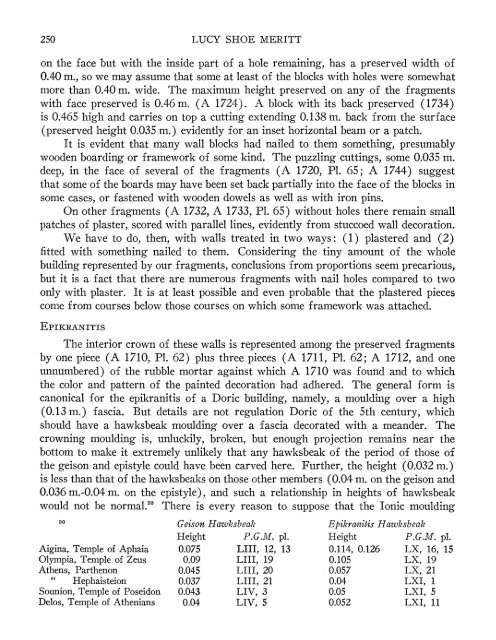the stoa poikile - The American School of Classical Studies at Athens
the stoa poikile - The American School of Classical Studies at Athens
the stoa poikile - The American School of Classical Studies at Athens
You also want an ePaper? Increase the reach of your titles
YUMPU automatically turns print PDFs into web optimized ePapers that Google loves.
250 LUCY SHOE MERITT<br />
on <strong>the</strong> face but with <strong>the</strong> inside part <strong>of</strong> a hole remaining, has a preserved width <strong>of</strong><br />
0.40 m., so we may assume th<strong>at</strong> some <strong>at</strong> least <strong>of</strong> <strong>the</strong> blocks with holes were somewh<strong>at</strong><br />
more than 0.40 m. wide. <strong>The</strong> maximum height preserved on any <strong>of</strong> <strong>the</strong> fragments<br />
with face preserved is 0.46 m. (A 1724). A block with its back preserved (1734)<br />
is 0.465 high and carries on top a cutting extending 0.138 m. back from <strong>the</strong> surface<br />
(preserved height 0.035 m.) evidently for an inset horizontal beam or a p<strong>at</strong>ch.<br />
It is evident th<strong>at</strong> many wall blocks had nailed to <strong>the</strong>m something, presumably<br />
wooden boarding or framework <strong>of</strong> some kind. <strong>The</strong> puzzling cuttings, some 0.035 m.<br />
deep, in <strong>the</strong> face <strong>of</strong> several <strong>of</strong> <strong>the</strong> fragments (A 1720, P1. 65; A 1744) suggest<br />
th<strong>at</strong> some <strong>of</strong> <strong>the</strong> boards may have been set back partially into <strong>the</strong> face <strong>of</strong> <strong>the</strong> blocks in<br />
some cases, or fastened with wooden dowels as well as with iron pins.<br />
On o<strong>the</strong>r fragments (A 1732, A 1733, P1. 65) without holes <strong>the</strong>re remain -small<br />
p<strong>at</strong>ches <strong>of</strong> plaster, scored with parallel lines, evidently from stuccoed wall decor<strong>at</strong>ion.<br />
We have to do, <strong>the</strong>n, with walls tre<strong>at</strong>ed in two ways: (1) plastered and (2)<br />
fitted with something nailed to <strong>the</strong>m. Considering <strong>the</strong> tiny amount <strong>of</strong> <strong>the</strong> whole<br />
building represented by our fragments, conclusions from proportions seem precarious,<br />
but it is a fact th<strong>at</strong> <strong>the</strong>re are numerous fragments with nail holes compared to two<br />
only with plaster. It is <strong>at</strong> least possible and even probable th<strong>at</strong> <strong>the</strong> plastered pieces<br />
come from courses below those courses on which some framework was <strong>at</strong>tached.<br />
EPIKRANITIS<br />
I <strong>The</strong> interior crown <strong>of</strong> <strong>the</strong>se walls is represented among <strong>the</strong> preserved fragments<br />
by -one piece (A 1710, P1. 62) plus three pieces (A 1711, P1. 62; A 1712, and one<br />
unnumbered) <strong>of</strong> <strong>the</strong> rubble mortar against which A 1710 was found and to which<br />
<strong>the</strong> color and p<strong>at</strong>tern <strong>of</strong> <strong>the</strong> painted decor<strong>at</strong>ion had adhered. <strong>The</strong> general form is<br />
canonical for <strong>the</strong> epikranitis <strong>of</strong> a Doric building, namely, a moulding over a high<br />
(0.13 m.) fascia. But details are not regul<strong>at</strong>ion Doric <strong>of</strong> <strong>the</strong> 5th century, which<br />
should have a hawksbeak moulding over a fascia decor<strong>at</strong>ed with a meander. <strong>The</strong><br />
crowning moulding is, unluckily, broken, but enough projection remains near <strong>the</strong><br />
bottom to make it extremely unlikely th<strong>at</strong> any hawksbeak <strong>of</strong> <strong>the</strong> period <strong>of</strong> those <strong>of</strong><br />
<strong>the</strong> geison and epistyle could have been carved here. Fur<strong>the</strong>r,' <strong>the</strong> height (0.032 m.)<br />
is less than th<strong>at</strong> <strong>of</strong> <strong>the</strong> hawksbeaks on those o<strong>the</strong>r members (0.04 m. on <strong>the</strong> geison and<br />
0.036 m.-0.04 m. on <strong>the</strong> epistyle), and such a rel<strong>at</strong>ionship in heights <strong>of</strong> hawksbeak<br />
would not be normal.30 <strong>The</strong>re is every reason to suppose th<strong>at</strong> <strong>the</strong> Ionic moulding<br />
30 Geison Hawksbeak Epikranitis Hawksbeak<br />
Height P.G.M. pl. Height P.G.M. pl.<br />
Aigina, Temple <strong>of</strong> Aphaia 0.075 LIII, 12, 13 0.114, 0.126 LX, 16, 15<br />
Olympia, Temple <strong>of</strong> Zeus 0.09 LIII, 19 0.105 LX, 19<br />
A<strong>the</strong>ns, Par<strong>the</strong>non 0.045 LIII, 20 0.057 LX, 21<br />
" Hephaisteion 0.037 LIII, 21 0.04 LXI, 1<br />
Sounion, Temple <strong>of</strong> Poseidon 0.043 LIV, 3 0.05 LXI, 5<br />
Delos, Temple <strong>of</strong> A<strong>the</strong>nians 0.04 LIV, 5 0.052 LXI, 11

















